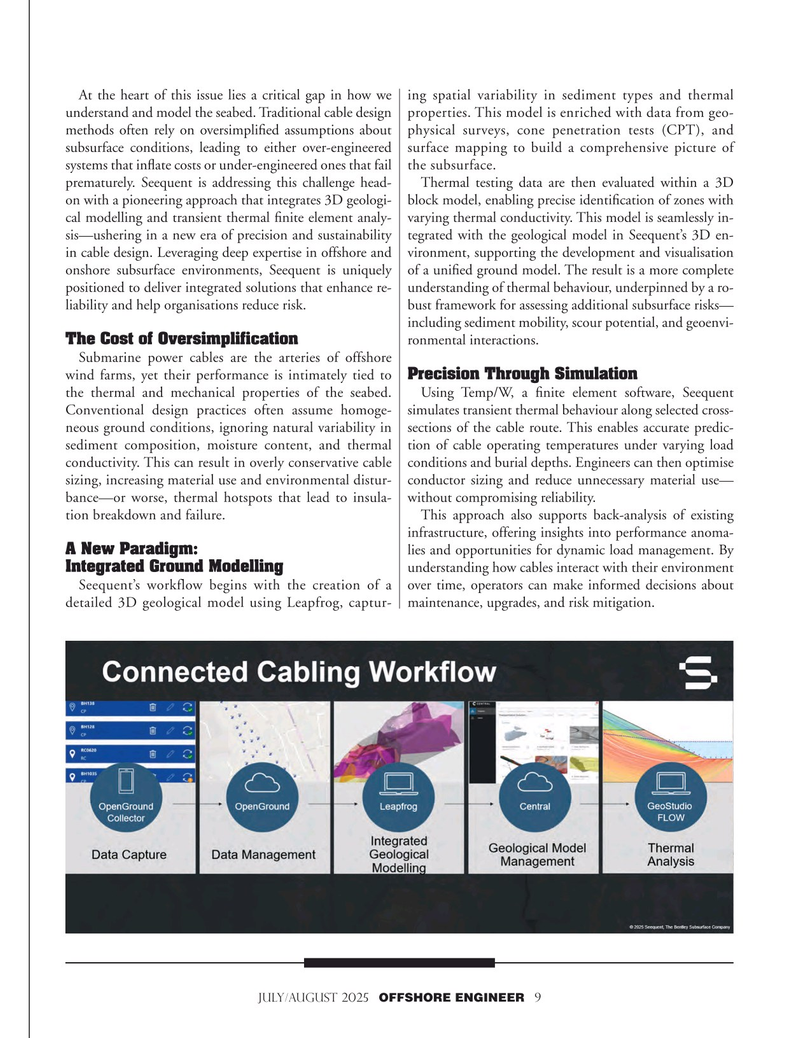
Page 9: of Offshore Engineer Magazine (Jul/Aug 2025)
Read this page in Pdf, Flash or Html5 edition of Jul/Aug 2025 Offshore Engineer Magazine
At the heart of this issue lies a critical gap in how we ing spatial variability in sediment types and thermal understand and model the seabed. Traditional cable design properties. This model is enriched with data from geo- methods often rely on oversimplifed assumptions about physical surveys, cone penetration tests (CPT), and subsurface conditions, leading to either over-engineered surface mapping to build a comprehensive picture of systems that infate costs or under-engineered ones that fail the subsurface.
prematurely. Seequent is addressing this challenge head- Thermal testing data are then evaluated within a 3D on with a pioneering approach that integrates 3D geologi- block model, enabling precise identifcation of zones with cal modelling and transient thermal fnite element analy- varying thermal conductivity. This model is seamlessly in- sis—ushering in a new era of precision and sustainability tegrated with the geological model in Seequent’s 3D en- in cable design. Leveraging deep expertise in offshore and vironment, supporting the development and visualisation onshore subsurface environments, Seequent is uniquely of a unifed ground model. The result is a more complete positioned to deliver integrated solutions that enhance re- understanding of thermal behaviour, underpinned by a ro- liability and help organisations reduce risk. bust framework for assessing additional subsurface risks— including sediment mobility, scour potential, and geoenvi-
The Cost of Oversimplification ronmental interactions.
Submarine power cables are the arteries of offshore wind farms, yet their performance is intimately tied to Precision Through Simulation the thermal and mechanical properties of the seabed. Using Temp/W, a fnite element software, Seequent
Conventional design practices often assume homoge- simulates transient thermal behaviour along selected cross- neous ground conditions, ignoring natural variability in sections of the cable route. This enables accurate predic- sediment composition, moisture content, and thermal tion of cable operating temperatures under varying load conductivity. This can result in overly conservative cable conditions and burial depths. Engineers can then optimise sizing, increasing material use and environmental distur- conductor sizing and reduce unnecessary material use— bance—or worse, thermal hotspots that lead to insula- without compromising reliability.
tion breakdown and failure. This approach also supports back-analysis of existing infrastructure, offering insights into performance anoma-
A New Paradigm: lies and opportunities for dynamic load management. By
Integrated Ground Modelling understanding how cables interact with their environment
Seequent’s workflow begins with the creation of a over time, operators can make informed decisions about detailed 3D geological model using Leapfrog, captur- maintenance, upgrades, and risk mitigation.
JULY/AUGUST 2025 OFFSHORE ENGINEER 9

 8
8

 10
10